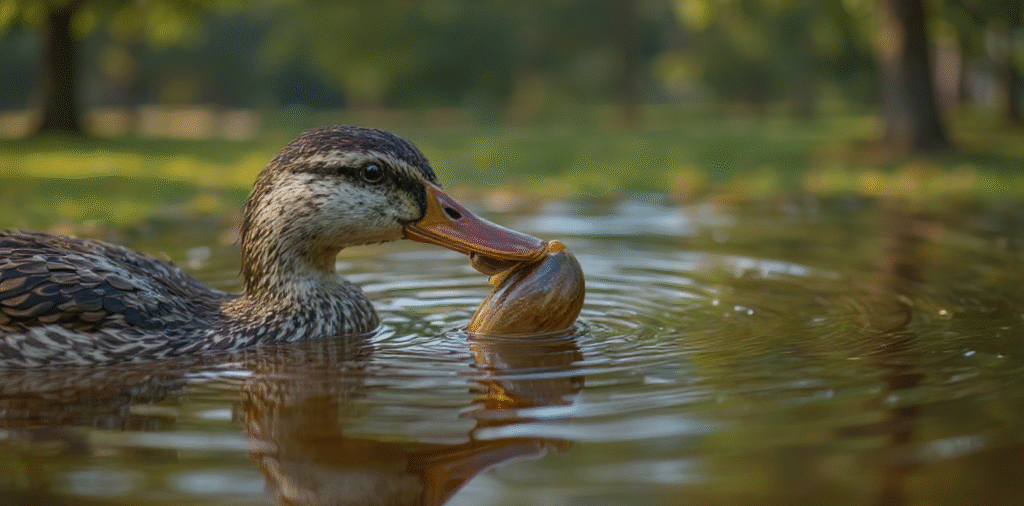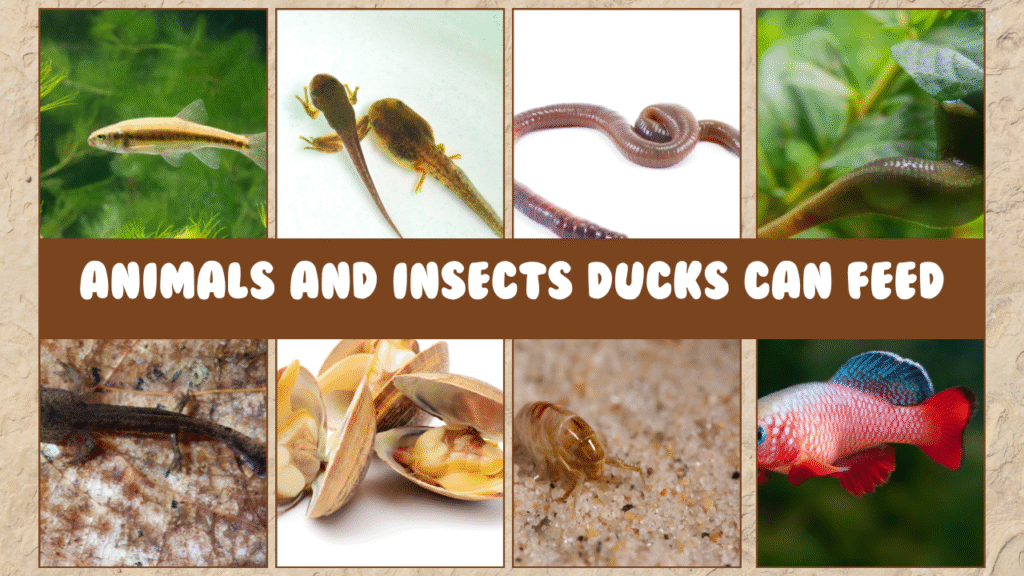A single mallard can consume over 10,000 insects in one day. Breeding female ducks derive up to 87% of their calories from animal sources. Growing ducklings require diets that are nearly 90% protein-rich invertebrates.
These statistics reveal a surprising truth: ducks aren’t the plant-eating, bread-loving birds most people imagine. They’re sophisticated omnivorous predators with remarkably diverse diets that include hundreds of different animal species—from microscopic water fleas to substantial crayfish.

Table of Contents
ToggleThe Omnivorous Nature of Ducks
Ducks belong to the family Anatidae and have evolved as opportunistic omnivores, meaning their digestive systems are perfectly adapted to process both plant and animal matter. This dietary flexibility has been crucial to their evolutionary success, allowing them to thrive in diverse aquatic and terrestrial environments across the globe.
The misconception that ducks are primarily vegetarian likely stems from observing their frequent foraging behavior in shallow waters and their enthusiastic response to bread and other carbohydrate-rich foods offered by humans. However, scientific research consistently shows that animal protein makes up a significant portion of most duck species’ natural diets, particularly during certain life stages and seasons.
Insects: A Crucial Component of Duck Diets
Insects represent one of the most important animal food sources for ducks. These protein-rich creatures are abundant in the aquatic environments where ducks spend most of their time, making them easily accessible and highly nutritious meals.
Aquatic Insects
Ducks consume numerous types of aquatic insects throughout their various life stages:
Chironomid larvae (midges) are perhaps the most important insect food for many duck species. These small, worm-like larvae live in the mud and sediment of ponds, lakes, and slow-moving streams. Ducks filter-feed through sediment to capture these protein-rich morsels, which can make up to 50% of some species’ diets during peak abundance periods.
Caddisfly larvae construct protective cases from small stones, plant matter, or other debris. Ducks have learned to extract these larvae from their cases, making them a valuable food source, especially for diving ducks that can reach deeper waters where these insects are more abundant.
Mayfly nymphs live underwater for most of their lives, making them perfect targets for foraging ducks. These insects are particularly important during their emergence periods when they become more active and vulnerable to predation.
Dragonfly and damselfly nymphs are larger aquatic insects that provide substantial nutrition. Their size makes them particularly attractive to larger duck species, and their predatory nature means they’re often found in areas rich with other small aquatic life.
Terrestrial Insects
While aquatic insects form the bulk of insect consumption, ducks also actively seek out terrestrial insects, especially during summer months when these creatures are most abundant:
Beetles of various species are commonly consumed, from small water beetles to larger ground beetles encountered during overland foraging. Their hard exoskeletons provide additional minerals, particularly calcium.
Flies and mosquitoes are easily captured both from the water surface and during flight. Adult flies emerging from aquatic environments are particularly vulnerable to duck predation.
Ants and other social insects become important food sources when ducks forage on land, particularly during nesting season when females need extra protein for egg production.
Complete List of Animals and Insects Ducks Consume
The following table provides a comprehensive overview of the various animals and insects that different duck species regularly consume:
| Category | Specific Animals/Insects | Primary Duck Species | Seasonal Importance | Nutritional Value |
| Aquatic Insects | Chironomid larvae (midges) | All species | Year-round, peak summer | High protein, essential amino acids |
| Caddisfly larvae | Diving ducks, dabblers | Spring through fall | Protein, minerals from cases | |
| Mayfly nymphs | All species | Spring emergence peak | High protein, easy to digest | |
| Dragonfly/Damselfly nymphs | Larger ducks, divers | Summer months | Large protein source | |
| Water beetles (adults & larvae) | All species | Year-round | Protein, calcium from exoskeleton | |
| Water boatmen | Dabblers, shallow divers | Spring through fall | Moderate protein | |
| Backswimmers | All species | Warm months | Protein, some fats | |
| Terrestrial Insects | Ants (various species) | Ground foragers | Summer, nesting season | Protein, formic acid |
| Flies and mosquitoes | All species | Warm months | Easy protein source | |
| Beetles (ground, dung) | Mallards, pintails | Spring through fall | Protein, minerals | |
| Caterpillars | Dabbling ducks | Spring and summer | High protein, fats | |
| Grasshoppers | Upland foragers | Late summer | Large protein source | |
| Small Fish | Minnows (fathead, emerald shiners) | Diving ducks | Year-round | Complete protein, omega-3s |
| Young game fish (bass, bluegill fry) | Divers, large dabblers | Spring spawning season | High protein, essential fats | |
| Sticklebacks | Northern species | Breeding season | Protein, calcium | |
| Killifish | Coastal species | Year-round | Protein, salt regulation | |
| Amphibians | Tadpoles (frog and toad) | All species | Spring through summer | High protein, easy to catch |
| Small frogs (tree frogs, chorus frogs) | Larger ducks | Breeding season | Complete protein | |
| Salamander larvae | Northern forest species | Spring and summer | High protein | |
| Mollusks | Pond snails | All species | Year-round | Protein, calcium for shells |
| Zebra/Quagga mussels | Diving ducks | Year-round | High protein, minerals | |
| Freshwater clams | Diving ducks | Year-round | Protein, calcium, filtering capability | |
| Marine snails (periwinkles) | Sea ducks | Year-round | Protein, salt adaptation | |
| Crustaceans | Freshwater shrimp (Gammarus) | All species | Peak in summer | High protein, essential fats |
| Crayfish (juveniles) | Larger species | Summer months | Complete protein, minerals | |
| Water fleas (Daphnia) | Filter feeders | Spring through fall | Easy protein source | |
| Copepods | All species | Year-round | Microscopic protein | |
| Marine amphipods | Sea ducks | Year-round | High protein, omega-3s | |
| Worms | Aquatic oligochaetes | All species | Year-round | Digestible protein |
| Earthworms | Ground foragers | Wet conditions | High protein, minerals | |
| Bloodworms (chironomid larvae) | Bottom feeders | Year-round | Iron-rich protein | |
| Marine polychaete worms | Sea ducks | Year-round | Protein, essential fatty acids | |
| Other Invertebrates | Leeches | Diving ducks | Warm months | Protein, blood nutrients |
| Water mites | Small ducks, ducklings | Summer | Microscopic protein | |
| Freshwater sponges | Specialized feeders | Limited seasons | Filtered nutrients | |
| Hydra and other cnidarians | Ducklings mainly | Warm months | Easy protein for young |
Beyond Insects: Other Animal Foods
While insects form a significant portion of the animal matter in duck diets, these versatile birds consume a wide range of other animal foods:
Small Fish and Aquatic Vertebrates
Many duck species, particularly diving ducks like canvasbacks and redheads, regularly consume small fish. These might include minnows, young game fish, and various small species that inhabit shallow waters. Some larger duck species can handle fish up to several inches in length.
Tadpoles and small frogs also feature prominently in duck diets, especially during spring and early summer when amphibian reproduction is at its peak. The high protein content of these creatures makes them particularly valuable for breeding females and growing ducklings.
Mollusks and Crustaceans
Snails are extremely important to many duck species, not just for their protein content but also for their shells, which provide essential calcium for eggshell formation. Ducks have powerful gizzards that can crush even relatively thick shells to access the nutritious meat inside.
Clams and mussels are consumed by diving ducks and other species capable of reaching them in deeper waters. Like snails, these mollusks provide both protein and essential minerals.
Crayfish and small crabs are taken when available, providing high-quality protein and essential fatty acids. These crustaceans are particularly important for larger duck species with more powerful bills.
Worms and Other Invertebrates
Earthworms become available to ducks when they forage in moist soil areas, particularly during rainy periods when worms surface. Aquatic worms, including various oligochaetes and polychaetes, are also important food sources in appropriate habitats.

Seasonal and Life Stage Variations
The importance of animal foods in duck diets varies significantly based on season and life stage:
Breeding Season
During breeding season, the demand for animal protein increases dramatically. Female ducks require high levels of protein and calcium for egg production, while males need energy-dense foods to maintain their condition during the energetically costly mating displays and territorial behaviors.
Research shows that some duck species derive up to 70% of their calories from animal sources during peak breeding season, compared to perhaps 20-30% during winter months.
Molting Period
During molt, when ducks shed and regrow their flight feathers, protein requirements again increase substantially. This flightless period often coincides with peak insect abundance in summer, providing the necessary nutrients for feather development.
Duckling Nutrition
Young ducklings have the highest protein requirements of any life stage, with some species requiring diets that are 80% or more animal matter during their first few weeks of life. This high protein requirement is essential for rapid growth and proper development.
Ducklings are particularly dependent on small, easily digestible invertebrates like chironomid larvae, small aquatic worms, and newly hatched insects. Parent ducks often lead their broods to areas with high concentrations of these foods.
Feeding Behavior and Foraging Strategies
Ducks have evolved various foraging strategies to capture their animal prey:
Dabbling
Surface-feeding ducks like mallards and pintails dabble at the surface, filtering water through their bills to capture floating insects, small crustaceans, and other invertebrates. Their bills contain numerous lamellae (comb-like structures) that act as filters.
Diving
Diving ducks can reach deeper waters where different prey species are available. This allows them to access larger fish, deeper-dwelling invertebrates, and bottom-dwelling organisms that dabbling ducks cannot reach.
Upending
Some species feed by tipping forward with their tails in the air, allowing them to reach vegetation and invertebrates in moderately deep water without fully diving.
Filter Feeding
Many ducks are accomplished filter feeders, pumping water through their specialized bills to capture tiny organisms. This technique is particularly effective for capturing small insects, crustaceans, and other microscopic animal life.
Nutritional Benefits of Animal Foods
Animal foods provide several crucial nutrients that are difficult to obtain from plant sources alone:
Complete proteins containing all essential amino acids necessary for growth, reproduction, and maintenance of body tissues.
Essential fatty acids, particularly omega-3 fatty acids found in aquatic animals, which are crucial for brain development, immune function, and reproductive success.
Minerals, especially calcium from shells and bones, iron from blood and tissues, and various trace minerals essential for proper physiological function.
Vitamins, particularly B-vitamins and vitamin D, which are often deficient in purely plant-based diets.
